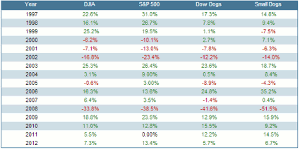Given the tremendous stock market gains in 2013, the bar of return expectations for 2014 is high, write the staff at Briefing.com.
'Tis the season for lists and there is one in particular that resonates for most of us this time of year: the Naughty and Nice list. We won't ask you to reveal where you reside on that list. That's between you and Santa. There is another list, however, that piques some interest for investors this time of year, too. It is the Dogs of the Dow list, which is oftentimes comprised of both naughty and nice stocks.
The Dogs of the Dow are the ten Dow Jones Industrial Average components with the highest dividend yield. Sometimes those high dividend yields are the result of falling stock prices (which puts stocks on the naughty list) while other times they are simply a case of a stock having a high dividend yield (which puts them on the nice list certainly for income-oriented investors).
To flush out that last point a little further, consider the cases of Hewlett-Packard (HPQ) and Verizon (VZ).
Last year, both stocks qualified to be in a Dogs of the Dow portfolio for 2013 with dividend yields of 3.72% and 4.76%, respectively, yet they got there by distinctly different paths. Hewlett-Packard started 2012 at a price of 25.76 per share and ended the year at 14.25. Accordingly, its high dividend yield was a function of naughty price action. Verizon, on the other hand, started the year at 40.12 and ended the year at 43.27. It trailed the broader market, but even with its price appreciation, it still offered investors a high dividend yield, which was nice.
Procedurally, it is a pretty simple process for investing in a Dogs of the Dow portfolio. After the market closes on the last day of the year, identify the ten highest-yielding Dow stocks, and then buy them at the start of the year investing an equal dollar amount in each of the stocks. Hold the stocks for a year and repeat the process at the end of the next year.
A variation of the strategy is to buy the five lowest-priced of the ten highest-yielding Dow stocks. These are called the "Small Dogs of the Dow." Again, one would purchase them at the end of the year, investing an equal dollar amount, and hold them for a year.
The website dogsofthedow.com offers an insightful look at the historical performance of the Dow Dogs and the process for carrying out this investment strategy.
Past performance, of course, is no guarantee of future results, yet the table below shows that the Dow Dogs strategy tends to work best when stock market gains are limited. In turn, it is more prone to underperformance when the stock market is rallying strongly because growth stocks rise more sharply than the less volatile Dow stocks.

Source: www.dogsofthedow.com
Click to Enlarge
Table Notes:
(1) The year reflects the performance of the stocks that made a Dow Dogs portfolio at the end of the prior year. For example, the 10 stocks that qualified to be in a Dow Dogs portfolio on Dec. 31, 1996, increased 17.3% in 1997.
(2) Changes do not include dividends, taxes or commissions
Given the tremendous gains in 2013, the bar of return expectations for 2014 is high.
A glimpse of S&P 500 annual price returns since 1929 showed there is no guarantee that the market will rise strongly for a third consecutive year. In fact, since 1929 the average price return for the S&P 500 in the third year following a gain of 10% or more in each of the previous two years has been -1.25%.
The range of returns in the 14 instances in which that third-year trade has been applicable spans from a loss of 38.6% in 1937 to a gain of 31.0% in 1997. Altogether, there have been seven "up" years in the third year (avg. gain 10.9%), six "down" years (avg. loss 15.6%), and one flat year.
If you're thinking 2014 is unlikely to be a banner year for stocks, one list you might be interested in seeing at year-end is the Dogs of the Dow list for 2014. According to dogsofthedow.com, the current frontrunners for that portfolio are:

Source: www.dogsofthedow.com
Click to Enlarge
Note: Prices are through close on Dec. 5, 2013
By the Staff of Briefing.com





















